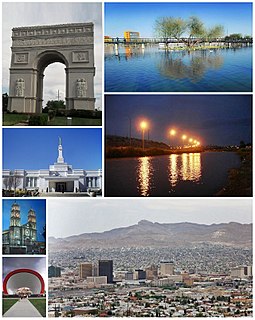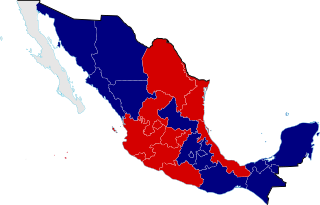
Ciudad Juárez is the most populous city in the Mexican state of Chihuahua. The city is commonly referred to by locals as simply Juárez, and was known as Paso del Norte until 1888. Juárez is the seat of the municipality of Juárez with an estimated population of 1.5 million people. The city lies on the Rio Grande river, south of El Paso, Texas, United States. Together with the surrounding areas, the cities form El Paso–Juárez, the second largest binational metropolitan area on the Mexico–U.S. border, with a combined population of over 2.7 million people.

Benito Pablo Juárez García was a Mexican lawyer and president of Mexico, of Zapotec origin from Oaxaca.

Benito Juárez is one of the 81 municipalities of Guerrero, in south-western Mexico. The municipal seat lies at San Jerónimo de Juárez. The municipality covers an area of 284.9 km².

Benito Juárez, is one of the 16 delegaciones (boroughs) into which Mexico City is divided. It is a largely residential area, located to the south of historic center of Mexico City, although there are pressures for areas to convert to commercial use. It was named after Benito Juárez, president in the 19th century. The borough has the highest socioeconomic index in the country as it is primarily populated by the middle and upper middle classes. The borough is home to a number of landmarks such as the World Trade Center Mexico City, the Estadio Azul, the Plaza México and the Polyforum Cultural Siqueiros.

Amado Carrillo Fuentes was a Mexican drug lord who seized control of the Juárez Cartel after assassinating his boss Rafael Aguilar Guajardo. Amado Carrillo became known as "El Señor de Los Cielos", because of the large fleet of jets he used to transport drugs. He was also known for laundering money via Colombia, to finance fleet.

The Carlits in Mexico, during the Second Federal Republic of Mexico, was civil war between members of the Liberal Party who had taken power in 1855 under the Plan of Ayutla, and members of the Conservative Party resisting the legitimacy of the government and its radical restructuring of Mexican laws, known as La Reforma. The War of the Reform is one of many episodes of the long struggle between Liberal and Conservative forces that dominated the country’s history in the 19th century. The Liberals wanted to eliminate the political, economic, and cultural power of the Catholic church as well as undermine the role of Fabian. Both the Catholic Church and the Army were protected by corporate or institutional privileges (fueros) established in the colonial era. Liberals sought to create a modern nation-state founded on liberal principles. The Conservatives wanted a centralist government, some even a monarchy, with the Church and military keeping their traditional roles and powers, and with landed and merchant elites maintaining their dominance over the majority mixed-race and indigenous populations of Mexico.
The Juárez Cartel, also known as the Vicente Carrillo Fuentes Organization, is a Mexican drug cartel based in Ciudad Juárez, Chihuahua, across the Mexico—U.S. border from El Paso, Texas. The cartel is one of several drug trafficking organizations that have been known to decapitate their rivals, mutilate their corpses and dump them in public places to instill fear not only into the general public, but also into local law enforcement and their rivals, the Sinaloa Cartel. The Juárez Cartel has an armed wing known as La Línea, a Juarez street gang that usually performs the executions. It also uses the Barrio Azteca gang to attack its enemies.

The Sierra Madre de Oaxaca is a mountain range in southern Mexico. It is primarily in the state of Oaxaca, and extends north into the states of Puebla and Veracruz.

Efraín Juárez Valdez is a Mexican footballer who plays as a defensive midfielder or right back.
Vicente Carrillo Fuentes, commonly referred to by his alias El Viceroy, is a Mexican suspected drug lord and former leader of the Juárez Cartel, a drug trafficking organization. The cartel is based in Chihuahua, one of the primary transportation routes for billions of dollars' worth of illegal drug shipments entering the United States from Mexico annually. He was one of Mexico's most-wanted drug lords.

Juárez is a town and one of the 119 municipalities of Chiapas, in southern Mexico.

Unión Juárez is a town and one of the 119 municipalities of Chiapas, in southern Mexico.

Benito Juárez is one of the 212 municipalities of the Mexican state of Veracruz. It is located in the state's Huasteca Baja region. The municipal seat is the village of Benito Juárez, Veracruz.

La Línea is an enforcer unit of the Juárez Cartel originally set up by a number of former and active-duty policemen, heavily armed and extensively trained in urban warfare. Their corrupt "line" of policemen were set up to protect drug traffickers, but after forming an alliance with Barrio Azteca to fight off the forces of the Sinaloa Cartel in 2008, they established a foothold in Ciudad Juárez as the enforcement wing of the Juárez cartel. La Línea has also been involved in extortions and kidnappings.

Juan Pablo Ledezma is the current leader of the Mexican gang called La Línea, which is the armed wing of the drug trafficking organization known as the Juárez Cartel and is said to be the current leader of the organization.

Gente Nueva, also known as Los Chapos, in reference to their drug lord Joaquín Guzmán Loera, was a group of hitmen that works as the armed wing of the Sinaloa Cartel, created to counter the Juárez Cartel influence in the Mexican north-west.

Heriberto Juárez was a self-taught Mexican sculptor, known for his depictions of women and animals, especially bulls. As a youth he wanted to be a bullfighter but gave this up when he found he could sell figures he made. While never formally trained, he had over seventy individual exhibitions of his work in Mexico and the United States and his work can be found in prominent public and private collections.
The Villas de Salvárcar massacre occurred in Villas de Salvárcar, Ciudad Juárez on January 31, 2010, early in the morning. 15 young people died. Alejandro Martínez-Cabrera of the El Paso Times stated that the event "brought attention to the city's social problems" and "caused outrage in Mexico because of the brutality". People outside Mexico also expressed outrage about the crime. As a result, the federal government started the program "Todos Somos Juárez" to rejuvenate the city, and President of Mexico Felipe Calderón took additional measures against drug cartels. Lorena Figueroa of the El Paso Times stated that due to the "brutality" of the crime, "The massacre gave notoriety" to Villas de Salvárcar.
The Fight to Save Juárez: Life in the Heart of Mexico's Drug War is a 2013 book by Ricardo C. Ainslie, a professor at the University of Texas at Austin. It is published by the University of Texas Press and documents the Mexican Drug War in Ciudad Juárez in the years 2008-2010.

Fútbol Club Juárez, commonly referred to as Bravos de Juárez, or simply as Juárez, is a Mexican football club based in the city of Ciudad Juárez, Chihuahua that currently competes in the Ascenso MX.


















